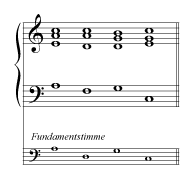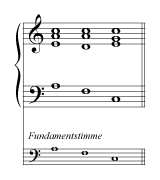Sixte ajoutée
Sixte ajoutée (French "added sixth"), short for Accord de la sixte ajoutée , also known as the subdominant fifth chord (Sigle: S 5 6 ), is the name introduced by Jean-Philippe Rameau for the major sixth step added to a triad . According to Rameau, the sixth ajoutée chord is a (compositional) subdominant . The characteristic dissonance gradually dissolves upwards with a simultaneous fourth case in the foundation. In the following example, according to Rameau, the tone d is to be regarded as sixte ajoutée, which gradually increases to the e the C major tonic resolves:
The opposite pole to subdominants and their specific chord resolution are, according to Rameau, dominants. A chord is called a dominant, which is characterized by the characteristic dissonance of the seventh, which gradually dissolves downwards with a simultaneous fifth fall in the foundation. Rameau even demands that sevenths that do not sound real should be included in the corresponding connections. The next note example shows a cadence which, according to Rameau, would have to be interpreted as a sequence of dominants: foundation a with added seventh g , foundation d with seventh c , "tonic dominant" with foundation g and an added seventh f as well as a concluding tonic c :

In contrast to Rameau's interpretation, in functional theory the sound dfac of the cadence (or the minor seventh chord of the second degree) is numbered as a subdominant with an added sixth or sixth ajoutée ( S 5 6 ).
The discrepancy between Rameauscher's interpretation and the functional-theoretical interpretation becomes obvious when one considers that in the second example the c of the second chord is dissonant, prepared and gradually resolved into the b downwards, while the functional designation Sixte ajoutée suggests that neither was preparing nor itself resolving d is the actual dissonance of the chord that was added to the F major chord. The sound fdac (read from bottom to top) can be found in both note examples : Whether this sound is a subdominant with sixth ajoutée (basic position: facd ) or a dominant with seventh (basic position: dfac ) in the sense of Rameau can only be determined through the resolution or determine via the context.
literature
- Jean-Philippe Rameau : Nouveau Système de musique théorique , Paris 1726
- Jean-Baptiste le Rond d'Alembert : Systematic introduction to musical typesetting according to the tenets of Mr. Rameau. Translated from the French and supplemented with notes by Friedr. Wilh. Marpurg , Leipzig 1757
Web links
- Online tutorial for Sixte ajoutée (musikanalyse.net)
